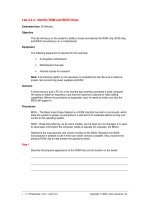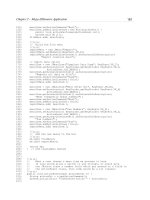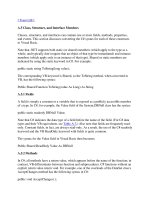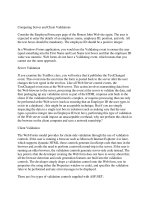Tài liệu LEARNING OBJECTIVES AND TEACHING ACTIVITIES docx
Bạn đang xem bản rút gọn của tài liệu. Xem và tải ngay bản đầy đủ của tài liệu tại đây (3.1 MB, 19 trang )
LEARNING OBJECTIVES
&
TEACHING ACTIVITIES
PRE-EMERGENT LITERACY LEVEL NOVICE LITERACY LEVEL
LISTENING/SPEAKING LISTENING/SPEAKING
Elementary Elementary
Middle School/Junior High Middle School/Junior High
High School High School
READING/PRINT AWARENESS READING/PRINT AWARENESS
Elementary Elementary
Middle School/Junior High Middle School/Junior High
High School High School
WRITING WRITING
Elementary Elementary
Middle School/Junior High Middle School/Junior High
High School High School
EMERGENT LITERACY LEVEL EXPERIMENTING LITERACY LEVEL
LISTENING/SPEAKING LISTENING/SPEAKING
Elementary Elementary
Middle School/Junior High Middle School/Junior High
High School High School
READING/PRINT AWARENESS READING/PRINT AWARENESS
Elementary Elementary
Middle School/Junior High Middle School/Junior High
High School High School
WRITING WRITING
Elementary Elementary
Middle School/Junior High Middle School/Junior High
High School High School
CONVENTIONAL LITERACY LEVEL
LISTENING/SPEAKING
Elementary
Middle School/Junior High
High School
READING/PRINT AWARENESS
Elementary
Middle School/Junior High
High School
WRITING
Elementary
Middle School/Junior High
High School
iv
Pre-Emergent Literacy Level
Students:
•
typically communicate in one to two-word verbal or picture symbol utterances to make simple
requests (e.g., for assistance, objects, and activities).
•
attend to completion of short activities (listen to a story, play a game, etc.).
•
understand and respond appropriately to some routine questions.
•
exhibit waiting and turn-taking.
•
attend more to pictures and the reader than to the print when stories are read aloud.
•
demonstrate minimal art/writing attempts.
•
identify familiar pictures and objects by name.
•
identify parts of a whole (e.g., parts of a book, body parts, etc.).
•
copy melodic speech patterns.
Learning Objectives: Listening/Speaking
The student will:
1. listen with increasing attention.
2. understand and follow simple, concrete commands with visual prompts.
3. listen to simple stories and request familiar stories.
4. show steady increase in listening and speaking vocabulary in everyday conversation.
5. listen with increased wattention to information, rhymes, songs, conversations, and stories.
Learning Objectives: Listening/Speaking
The student will:
1. examine and label pictures in books and point to pictures to request that adult name te picture.
2. repeat part of text on a page immediately after it has been read aloud by an adult.
3. recognize favorite books by the cover.
4. frequently request the re-reading of books.
Learning Objectives: Listening/Speaking
The student will:
1. randomly draw and scribble.
2. use a variety of writing and art tools to create a finished product.
v
PRE-EMERGENT
LISTENING/SPEAKING
vi
T.E.K.S. (K.1) The student listens attentively and engages in a variety of oral language experiences.
Area: Pre-Emergent Listening/Speaking
Pre-Emergent E-1
OBJECTIVE TEACHING ACTIVITIES
1. The student will listen with increasing
attention.
1. Students will interact with teacher in small
groups. Play games such as finger plays,
Simon Says, Red-Light Green-Light. Read
and re-read stories with repeated lines.
Dictate stories about classroom
experiences. Increase duration of group
story time as listening skills develop.
2. Provide a listening center with stories on
tape. Give all students an opportunity to
listen to stories daily.
RESOURCES/MATERIALS
Adaptations:
Various children’s books
Big books
Flannel board stories
Pictures to sequence
•
Large picture books with one or two objects
on each page (i.e., picture of ball and word
“ball”)
•
Simple voice output devices programmed
with repeated lines from stories
Pre-Kindergarten Curriculum Guidelines: The student is able to comprehend what he/she hears in
conversations and in stories read aloud.
Area: Pre-Emergent Listening/Speaking
OBJECTIVE TEACHING ACTIVITIES
2. The student will understand and follow
simple, concrete commands with visual
prompts.
1. Given a picture symbol, student will match
picture to concrete object.
2. When presented a picture of an activity
(walking, jumping, yawning, etc.), student
will imitate activity.
3. Sing “Itsy Bitsy Spider” or other finger
play. Students imitate teacher’s hand
movements.
4. Student will learn to follow simple daily
routine instructions (i.e., take off your coat,
sit down, get your cup, etc.) Use picture or
object symbol cues when needed.
RESOURCES/MATERIALS
Adaptations:
Magazine pictures showing actions
Flannel board/magnetic board
Pictures for “Itsy Bitsy Spider”
Picture symbols and associated objects
•
Object/character props on Popsicle sticks /
tongue depressors for students (as needed)
•
Picture or object symbols
Pre-Emergent E-2
Pre-Kindergarten Curriculum Guidelines: The student communicates by putting thoughts, feelings and
requests into words, signs or symbols.
Area: Pre-Emergent Listening/Speaking
Pre-Emergent E-3
OBJECTIVE TEACHING ACTIVITIES
3. The student will listen to simple stories and
request familiar stories.
1. Teacher and students will engage in reading
Big books, poems, charts, and storybooks
on tape.
2. Students can request stories by name or
main character. For students who are non-
verbal, teacher can reproduce a picture of a
story character from a specific book (i.e.,
Arthur or Clifford) or reproduce book
jacket or title page, as needed. Maintain a
“file” for students to make selections.
RESOURCES/MATERIALS
Adaptations:
Big books
Storybooks
Storybooks on tape
Symbols/pictures to represent book titles
•
Plastic/plush character to represent book
character.
•
Program multi-location voice output
devices with titles of familiar books.
Pre-Kindergarten Curriculum Guidelines: The student develops new concepts, acquires new words, and
increasingly refines his/her understanding of words that he/she already knows.
Area: Pre-Emergent Listening/Speaking
Pre-Emergent E-4
OBJECTIVE TEACHING ACTIVITIES
4. The student will show steady increase in
listening and speaking vocabulary in
everyday conversation.
1. Provide opportunities for dramatic play.
The student will practice conversation
skills, taking turns, providing information,
and making requests when role-playing
pretend activities such as dress-up, using
the telephone, playing store, etc.
2. Provide Community Based Instruction
having students practice ordering, making
choices, requesting specific items, etc.
RESOURCES/MATERIALS
Adaptations:
Telephones
Props for role-playing
•
Simple voice output devices and/or picture
symbols for non-verbal students to show
understanding, comment, ask questions,
etc.









